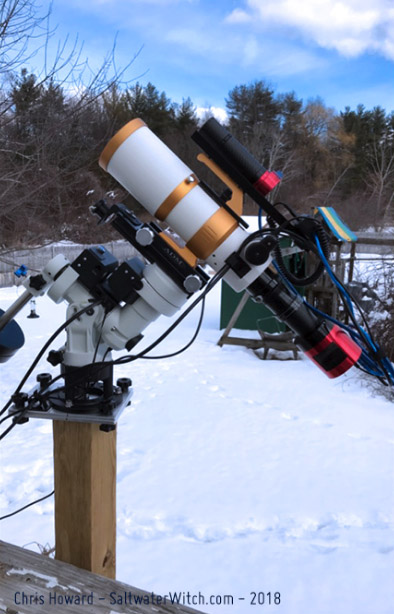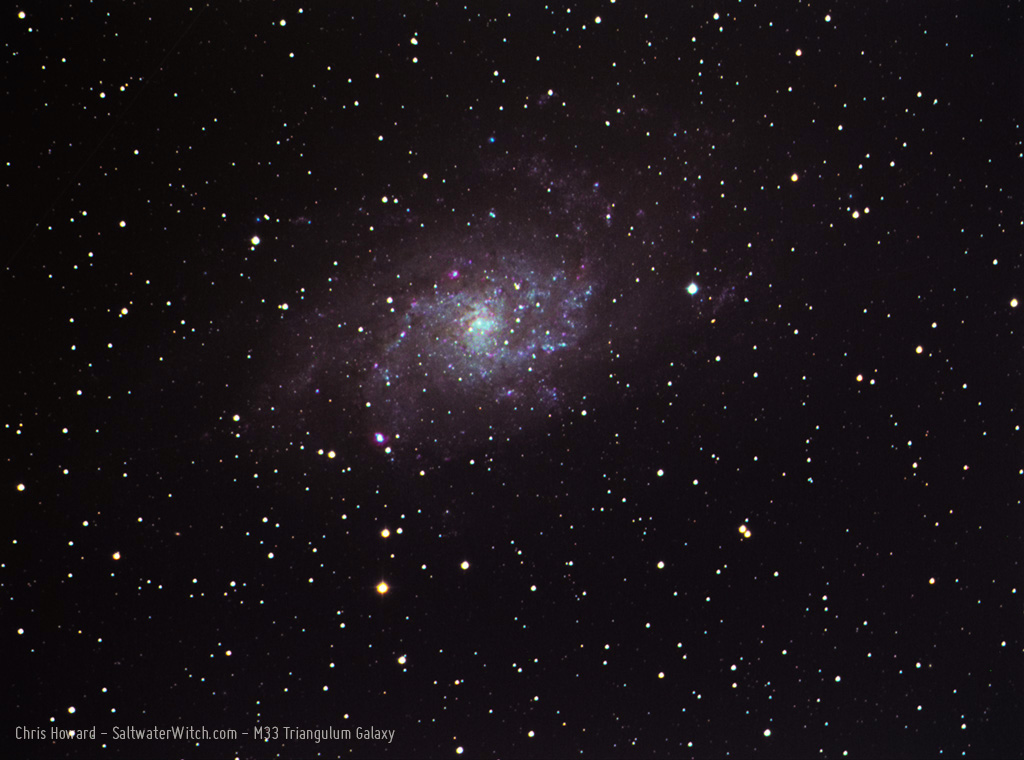Astro Session - April 5, 2018
As the days become longer, as we swing around our sun, headed for aphelion in July (greatest distance from the sun), and our planet's 23.5 degree tilt is angled toward its rays, we'll be seeing less of the constellation Orion--in normal viewing hours. I took this 30 second exposure last night around 9PM, and Orion is already moving below the trees to the southwest. That's the Pleiades (M45) at the far right. I also happened to capture the headlights and brakelights of Alice's car as she's driving past to our driveway, almost home after picking up Christopher from work.

Posted April 5, 2018
Astro Session - March 16, 2018
 This was the first chance I've had to put the ZWO ASI071MC through some serious long exposure tests on four very different targets, the region around Alnitak in Orion, the Rosette Nebula, Markarian's Chain, and M101. I ran most of these frames with unity gain (90 Gain, 20 Offset), and I built up a nice library of dark calibration frames in the afternoon, for 600, 300, and 120 second exposure times.
This was the first chance I've had to put the ZWO ASI071MC through some serious long exposure tests on four very different targets, the region around Alnitak in Orion, the Rosette Nebula, Markarian's Chain, and M101. I ran most of these frames with unity gain (90 Gain, 20 Offset), and I built up a nice library of dark calibration frames in the afternoon, for 600, 300, and 120 second exposure times.
Rosette Nebular Region - Caldwell 49 (13 x 300 sec frames, 24 dark calibration frames) in the constellation Monoceros, about 5000 lightyears from earth. William Optics GT81 APO refractor, ZWO ASI071MC-C camera, iOptron CEM25P EQ mount.
A whole string of galaxies millions of lightyears from earth. Markarian's Chain in the Virgo Cluster, including M84, M86, the Eyes Galaxies (NGC 4435 and NGC 4438) and a few more galaxies and galaxy pairs. The Eyes are 52 million lightyears away! 30 x 120 sec frames, 20 dark frames, stacked in DSS. William Optics GT81 APO refractor, ZWO ASI071MC-C camera, iOptron CEM25P EQ mount.

Pinwheel Galaxy, M101, a spiral galaxy about 21 million lightyears from earth in the constellation Ursa Major (Big Dipper). (Light frames: 10 x 120 secs, 4 x 600 secs, 12 x 300 secs). William Optics GT81 APO refractor, ZWO ASI071MC-C camera, iOptron CEM25P EQ mount, INDI/KStars/Ekos.


Part of the Orion Molecular Cloud Complex that surrounds the blue supergiant Alnitak (large star in the center), including the Flame Nebula (NGC 2024), IC 434, Horsehead Nebula (Barnard 33), NGC 2023, IC 431, and more. About 1500 lightyears from earth. (22 x 300 sec frames, 24 dark frames). William Optics GT81 APO refractor, ZWO ASI071MC-C camera, iOptron CEM25P EQ mount. In case you're wondering, I'm pretty damned excited about this camera (ZWO ASI071MC), just going off what it can capture in faint nebulosity, and what I can bring out without much effort by stretching 22 stacked frames. I can't wait to see what I can capture in the summer when the big galaxies like Andromeda and Triangulum swing through.

Here's my setup for last night's astro session, with the William Optics GT81 APO refractor, ZWO ASI071MC-C primary camera, iOptron CEM25P EQ mount.

Posted March 16, 2018
Astro Session - March 11, 2018
 First test shots of M42, the Orion Nebula, M43 De Mairan’s Nebula, Sh2-279 Running Man with the ZWO ASI071MC cooled CMOS camera. No calibration frames, just 17 stacked 300 second light frames, with the sensor cooled to -10C. Last night was not very clear, scattered clouds, fairly poor seeing. I can't wait to test things out with some really clear and dark skies. I definitely need cal frames, because things ended up pretty noisy after processing. I will say, so far, with only a few hours of use, I'm impressed with this ZWO color camera. That doesn't surprise me. ZWO makes a solid camera--I've been using an ASI120MM-S for several years, as my guide camera. It's fast--USB 3, with a small but very sensitive monochrome sensor, and it just always works under any OS on a variety of hardware--Windows, Linux, MacOS. That's what I meant--it shouldn't surprise me that the ASI071MC (quite a bit more expensive and a far more capable camera) just works well. What did surprise me is how much this camera can pick up, bringing out some very faint nebulous areas. I know it has a very wide/high dynamic range. That's one of the things I was looking for in an OSC camera. For this M42 test I used a Gain of 0 and Offset of 8, the minimum recommended by ZWO for long exposure times and HDR (high dynamic range). We'll see how things go on the next clear night. I'd like to test out unity gain settings, and LRN (Lowest read noise) setting, which is high gain, high offset, used for short exposures. (William Optics GT-81 + 0.8x Field Flattener/Reducer f/4.7, ZWO ASI071MC cooled CMOS camera, iOptron CEM25P EQ mount, 30mm mini guide scope with ZWO ASI120MM-S guide cam, INDI/KStars/Ekos observatory control. Location: Stratham, New Hampshire, US. Bortle ~4). Astrobin
First test shots of M42, the Orion Nebula, M43 De Mairan’s Nebula, Sh2-279 Running Man with the ZWO ASI071MC cooled CMOS camera. No calibration frames, just 17 stacked 300 second light frames, with the sensor cooled to -10C. Last night was not very clear, scattered clouds, fairly poor seeing. I can't wait to test things out with some really clear and dark skies. I definitely need cal frames, because things ended up pretty noisy after processing. I will say, so far, with only a few hours of use, I'm impressed with this ZWO color camera. That doesn't surprise me. ZWO makes a solid camera--I've been using an ASI120MM-S for several years, as my guide camera. It's fast--USB 3, with a small but very sensitive monochrome sensor, and it just always works under any OS on a variety of hardware--Windows, Linux, MacOS. That's what I meant--it shouldn't surprise me that the ASI071MC (quite a bit more expensive and a far more capable camera) just works well. What did surprise me is how much this camera can pick up, bringing out some very faint nebulous areas. I know it has a very wide/high dynamic range. That's one of the things I was looking for in an OSC camera. For this M42 test I used a Gain of 0 and Offset of 8, the minimum recommended by ZWO for long exposure times and HDR (high dynamic range). We'll see how things go on the next clear night. I'd like to test out unity gain settings, and LRN (Lowest read noise) setting, which is high gain, high offset, used for short exposures. (William Optics GT-81 + 0.8x Field Flattener/Reducer f/4.7, ZWO ASI071MC cooled CMOS camera, iOptron CEM25P EQ mount, 30mm mini guide scope with ZWO ASI120MM-S guide cam, INDI/KStars/Ekos observatory control. Location: Stratham, New Hampshire, US. Bortle ~4). Astrobin

Posted March 11, 2018
Astro Session - January 10, 2018
The temps are nice--downright warm compared to what we've been hit with over the last couple weeks. The clouds are the problem. They gave me two hours of clear skies, and I spent them taking a batch of five minute exposures of M42, the Orion Nebula. (Atik414Ex mono CCD, William Optics GT-81 + 0.8x Field Flattener/Reducer f/4.7, iOptron CEM25P EQ mount, Astronomik 12nm Ha filter, WO 50mm guidescope with ZWO ASI120S-MM guide cam, INDI/KStars/Ekos observatory control).

Posted January 10, 2018
Astro Session - November 10, 2017
M33 Triangulum Galaxy, about 3 million lightyears away, so... not that far. M33 is a relatively small spiral galaxy with only 40 billion stars. I'm having some trouble with my guide camera (ZWO ASI120MM), so this is all unguided. I took 80 LRGB exposures--120 seconds each, 10 Ha frames at 120 secs, 20 dark calibration frames, stacked in DSS).

Posted November 10, 2017
Astro Session - October 18, 2017
The three central and brightest (low magnitude) stars in the open star cluster M45, called The Pleiades or The Seven Sisters: Alcyone (upper middle), Maia (right), and Merope (left). The light of the stars in the Pleiades pass through and illuminate a cloud of dust in the interstellar medium. (8 x 5 minute exposures, 18 dark frames - William Optics GT-81 478mm FL, Atik 414EX Monochrome CCD, Baader luminance filter, CEM25P EQ mount).

Posted October 18, 2017
Astro Session - October 17, 2017
Color version of M81 (Bode's Galaxy) in the constellation Ursa Major (Big Dipper). From another set of subs I shot at 4am--this time with the color QHY CMOS camera, QHY5III178. Info: 21 x 300 sec. with 20 dark frames, QHY5III178 color CMOS, William Optics GT-81, CEM25P EQ mount, WO 50mm guidescope with ZWO ASI120S-MM guide cam, INDI/KStars/Ekos observatory control.

Posted October 17, 2017
Astro Session - October 12, 2017
M81 (Bode's Galaxy) and M82 (Cigar Galaxy) in the constellation Ursa Major (Big Dipper). I was up at 4am, and there's the big dipper swinging around and climbing into the sky. Bode's and the cigar galaxy were just waiting to be captured. Info: 15 x 120 sec. with 10 dark frames, Atik414Ex mono CCD, William Optics GT-81, CEM25P EQ mount, WO 50mm guidescope with ZWO ASI120S-MM guide cam, INDI/KStars/Ekos observatory control.

